2020 MASERATI GRANTURISMO light
[x] Cancel search: lightPage 260 of 286
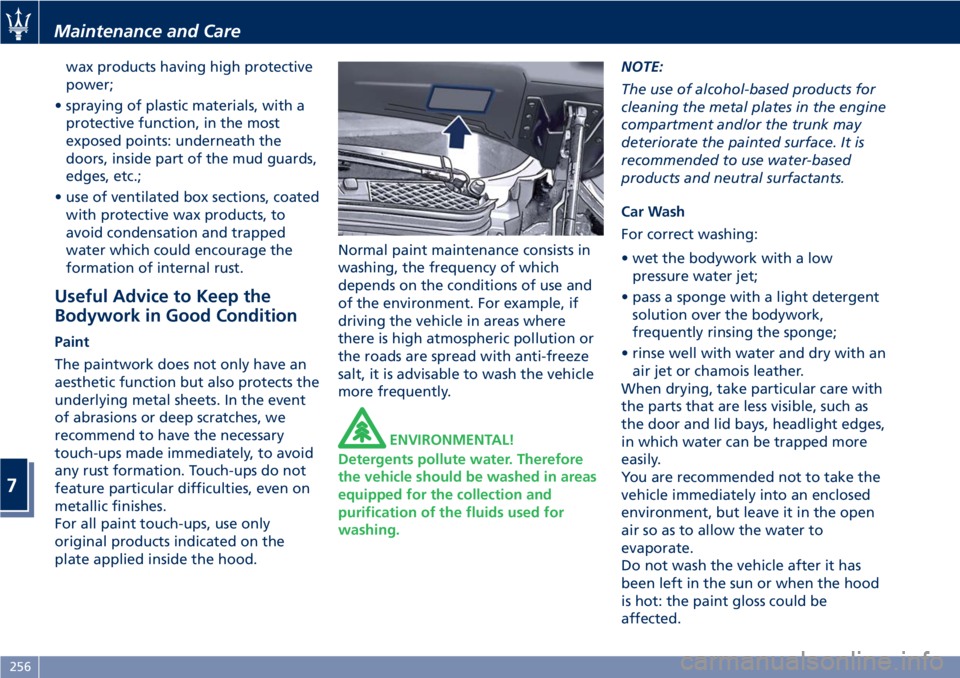
wax products having high protective
power;
• spraying of plastic materials, with a
protective function, in the most
exposed points: underneath the
doors, inside part of the mud guards,
edges, etc.;
• use of ventilated box sections, coated
with protective wax products, to
avoid condensation and trapped
water which could encourage the
formation of internal rust.
Useful Advice to Keep the
Bodywork in Good Condition
Paint
The paintwork does not only have an
aesthetic function but also protects the
underlying metal sheets. In the event
of abrasions or deep scratches, we
recommend to have the necessary
touch-ups made immediately, to avoid
any rust formation. Touch-ups do not
feature particular difficulties, even on
metallic finishes.
For all paint touch-ups, use only
original products indicated on the
plate applied inside the hood.Normal paint maintenance consists in
washing, the frequency of which
depends on the conditions of use and
of the environment. For example, if
driving the vehicle in areas where
there is high atmospheric pollution or
the roads are spread with anti-freeze
salt, it is advisable to wash the vehicle
more frequently.
ENVIRONMENTAL!
Detergents pollute water. Therefore
the vehicle should be washed in areas
equipped for the collection and
purification of the fluids used for
washing.NOTE:
The use of alcohol-based products for
cleaning the metal plates in the engine
compartment and/or the trunk may
deteriorate the painted surface. It is
recommended to use water-based
products and neutral surfactants.
Car Wash
For correct washing:
• wet the bodywork with a low
pressure water jet;
• pass a sponge with a light detergent
solution over the bodywork,
frequently rinsing the sponge;
• rinse well with water and dry with an
air jet or chamois leather.
When drying, take particular care with
the parts that are less visible, such as
the door and lid bays, headlight edges,
in which water can be trapped more
easily.
You are recommended not to take the
vehicle immediately into an enclosed
environment, but leave it in the open
air so as to allow the water to
evaporate.
Do not wash the vehicle after it has
been left in the sun or when the hood
is hot: the paint gloss could be
affected.
Maintenance and Care
7
256
Page 261 of 286
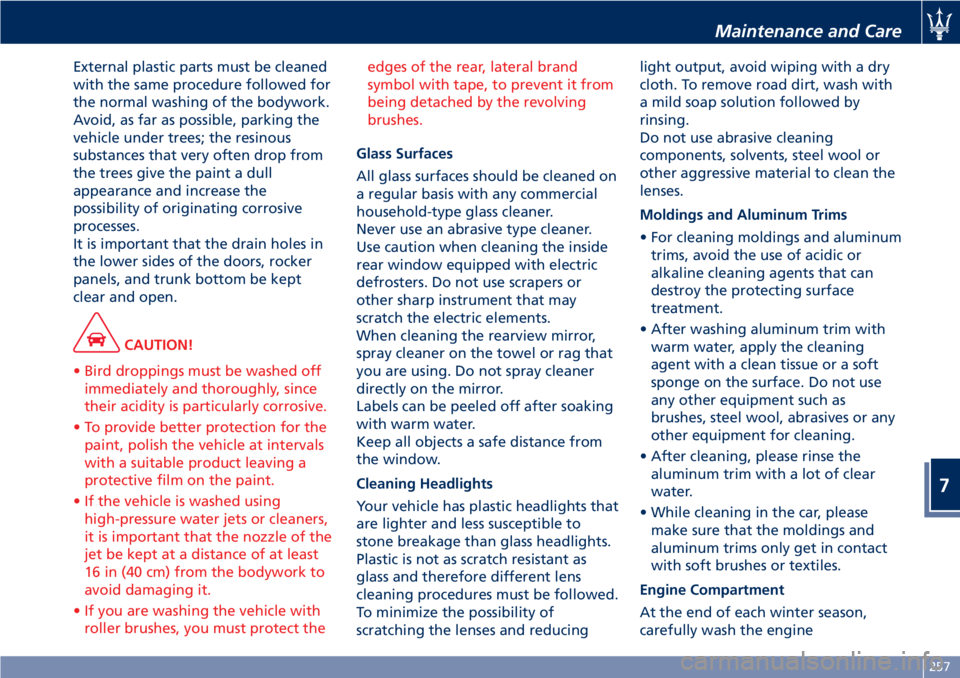
External plastic parts must be cleaned
with the same procedure followed for
the normal washing of the bodywork.
Avoid, as far as possible, parking the
vehicle under trees; the resinous
substances that very often drop from
the trees give the paint a dull
appearance and increase the
possibility of originating corrosive
processes.
It is important that the drain holes in
the lower sides of the doors, rocker
panels, and trunk bottom be kept
clear and open.
CAUTION!
• Bird droppings must be washed off
immediately and thoroughly, since
their acidity is particularly corrosive.
• To provide better protection for the
paint, polish the vehicle at intervals
with a suitable product leaving a
protective film on the paint.
• If the vehicle is washed using
high-pressure water jets or cleaners,
it is important that the nozzle of the
jet be kept at a distance of at least
16 in (40 cm) from the bodywork to
avoid damaging it.
• If you are washing the vehicle with
roller brushes, you must protect theedges of the rear, lateral brand
symbol with tape, to prevent it from
being detached by the revolving
brushes.
Glass Surfaces
All glass surfaces should be cleaned on
a regular basis with any commercial
household-type glass cleaner.
Never use an abrasive type cleaner.
Use caution when cleaning the inside
rear window equipped with electric
defrosters. Do not use scrapers or
other sharp instrument that may
scratch the electric elements.
When cleaning the rearview mirror,
spray cleaner on the towel or rag that
you are using. Do not spray cleaner
directly on the mirror.
Labels can be peeled off after soaking
with warm water.
Keep all objects a safe distance from
the window.
Cleaning Headlights
Your vehicle has plastic headlights that
are lighter and less susceptible to
stone breakage than glass headlights.
Plastic is not as scratch resistant as
glass and therefore different lens
cleaning procedures must be followed.
To minimize the possibility of
scratching the lenses and reducinglight output, avoid wiping with a dry
cloth. To remove road dirt, wash with
a mild soap solution followed by
rinsing.
Do not use abrasive cleaning
components, solvents, steel wool or
other aggressive material to clean the
lenses.
Moldings and Aluminum Trims
• For cleaning moldings and aluminum
trims, avoid the use of acidic or
alkaline cleaning agents that can
destroy the protecting surface
treatment.
• After washing aluminum trim with
warm water, apply the cleaning
agent with a clean tissue or a soft
sponge on the surface. Do not use
any other equipment such as
brushes, steel wool, abrasives or any
other equipment for cleaning.
• After cleaning, please rinse the
aluminum trim with a lot of clear
water.
• While cleaning in the car, please
make sure that the moldings and
aluminum trims only get in contact
with soft brushes or textiles.
Engine Compartment
At the end of each winter season,
carefully wash the engine
Maintenance and Care
7
257
Page 264 of 286
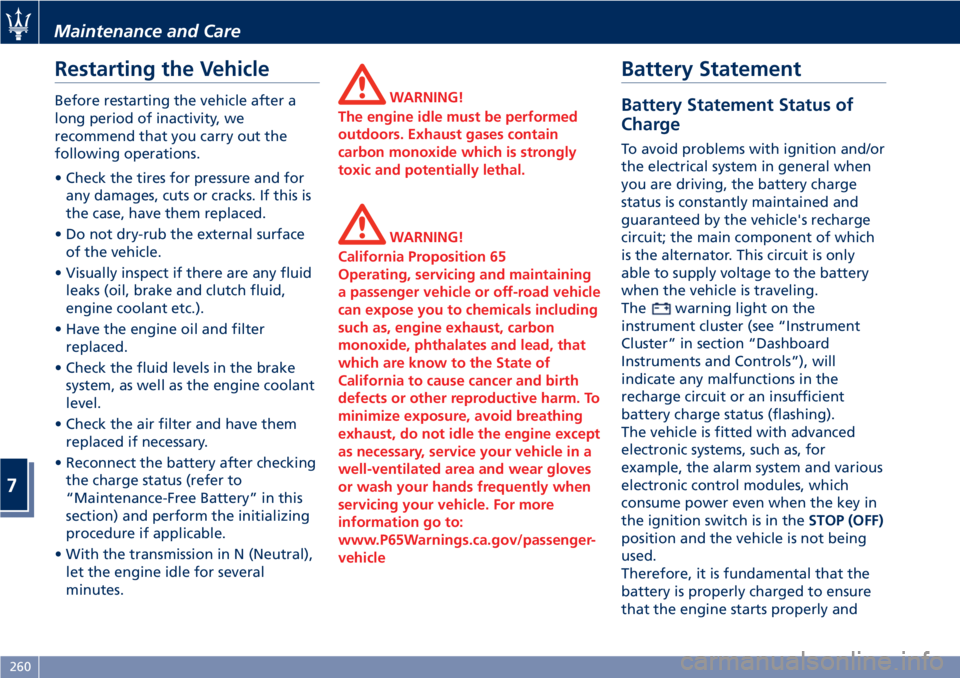
Restarting the Vehicle
Before restarting the vehicle after a
long period of inactivity, we
recommend that you carry out the
following operations.
• Check the tires for pressure and for
any damages, cuts or cracks. If this is
the case, have them replaced.
• Do not dry-rub the external surface
of the vehicle.
• Visually inspect if there are any fluid
leaks (oil, brake and clutch fluid,
engine coolant etc.).
• Have the engine oil and filter
replaced.
• Check the fluid levels in the brake
system, as well as the engine coolant
level.
• Check the air filter and have them
replaced if necessary.
• Reconnect the battery after checking
the charge status (refer to
“Maintenance-Free Battery” in this
section) and perform the initializing
procedure if applicable.
• With the transmission in N (Neutral),
let the engine idle for several
minutes.WARNING!
The engine idle must be performed
outdoors. Exhaust gases contain
carbon monoxide which is strongly
toxic and potentially lethal.
WARNING!
California Proposition 65
Operating, servicing and maintaining
a passenger vehicle or off-road vehicle
can expose you to chemicals including
such as, engine exhaust, carbon
monoxide, phthalates and lead, that
which are know to the State of
California to cause cancer and birth
defects or other reproductive harm. To
minimize exposure, avoid breathing
exhaust, do not idle the engine except
as necessary, service your vehicle in a
well-ventilated area and wear gloves
or wash your hands frequently when
servicing your vehicle. For more
information go to:
www.P65Warnings.ca.gov/passenger-
vehicle
Battery Statement
Battery Statement Status of
Charge
To avoid problems with ignition and/or
the electrical system in general when
you are driving, the battery charge
status is constantly maintained and
guaranteed by the vehicle's recharge
circuit; the main component of which
is the alternator. This circuit is only
able to supply voltage to the battery
when the vehicle is traveling.
The
warning light on the
instrument cluster (see “Instrument
Cluster” in section “Dashboard
Instruments and Controls”), will
indicate any malfunctions in the
recharge circuit or an insufficient
battery charge status (flashing).
The vehicle is fitted with advanced
electronic systems, such as, for
example, the alarm system and various
electronic control modules, which
consume power even when the key in
the ignition switch is in theSTOP (OFF)
position and the vehicle is not being
used.
Therefore, it is fundamental that the
battery is properly charged to ensure
that the engine starts properly and
Maintenance and Care
7
260
Page 266 of 286
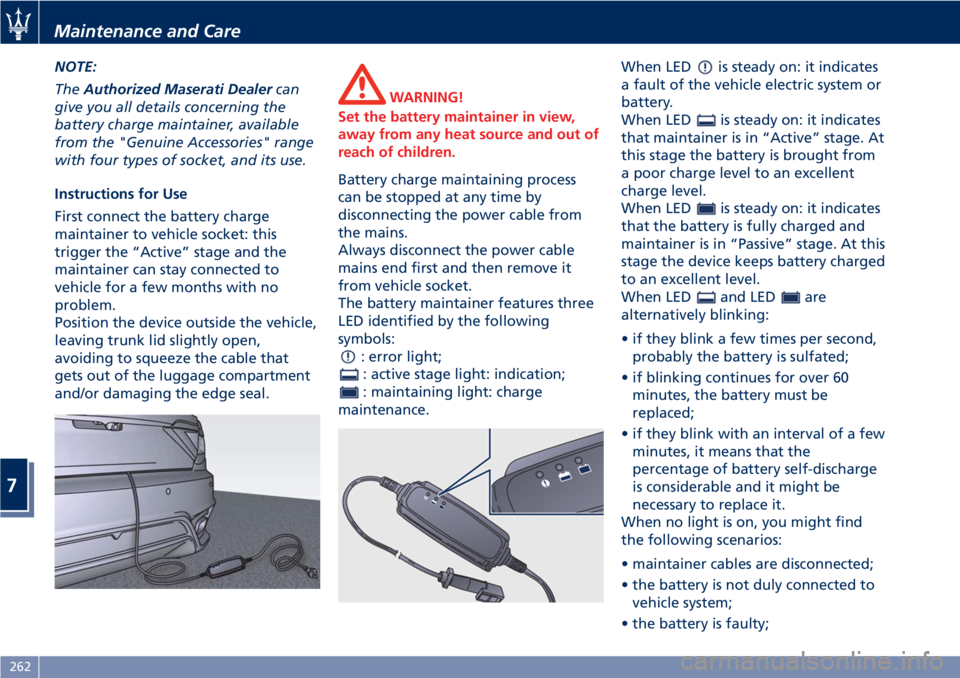
NOTE:
TheAuthorized Maserati Dealercan
give you all details concerning the
battery charge maintainer, available
from the "Genuine Accessories" range
with four types of socket, and its use.
Instructions for Use
First connect the battery charge
maintainer to vehicle socket: this
trigger the “Active” stage and the
maintainer can stay connected to
vehicle for a few months with no
problem.
Position the device outside the vehicle,
leaving trunk lid slightly open,
avoiding to squeeze the cable that
gets out of the luggage compartment
and/or damaging the edge seal.
WARNING!
Set the battery maintainer in view,
away from any heat source and out of
reach of children.
Battery charge maintaining process
can be stopped at any time by
disconnecting the power cable from
the mains.
Always disconnect the power cable
mains end first and then remove it
from vehicle socket.
The battery maintainer features three
LED identified by the following
symbols:
: error light;
: active stage light: indication;
: maintaining light: charge
maintenance.When LED
is steady on: it indicates
a fault of the vehicle electric system or
battery.
When LED
is steady on: it indicates
that maintainer is in “Active” stage. At
this stage the battery is brought from
a poor charge level to an excellent
charge level.
When LED
is steady on: it indicates
that the battery is fully charged and
maintainer is in “Passive” stage. At this
stage the device keeps battery charged
to an excellent level.
When LED
and LEDare
alternatively blinking:
• if they blink a few times per second,
probably the battery is sulfated;
• if blinking continues for over 60
minutes, the battery must be
replaced;
• if they blink with an interval of a few
minutes, it means that the
percentage of battery self-discharge
is considerable and it might be
necessary to replace it.
When no light is on, you might find
the following scenarios:
• maintainer cables are disconnected;
• the battery is not duly connected to
vehicle system;
• the battery is faulty;
Maintenance and Care
7
262
Page 270 of 286
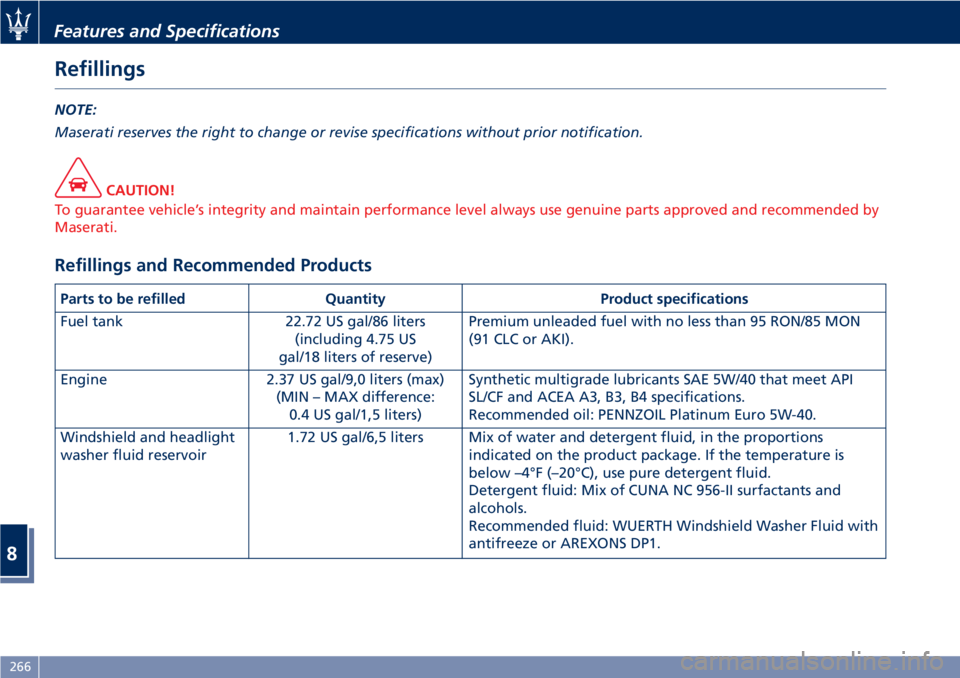
Refillings
NOTE:
Maserati reserves the right to change or revise specifications without prior notification.
CAUTION!
To guarantee vehicle’s integrity and maintain performance level always use genuine parts approved and recommended by
Maserati.
Refillings and Recommended Products
Parts to be refilled Quantity Product specifications
Fuel tank 22.72 US gal/86 liters
(including 4.75 US
gal/18 liters of reserve)Premium unleaded fuel with no less than 95 RON/85 MON
(91 CLC or AKI).
Engine 2.37 US gal/9,0 liters (max)
(MIN – MAX difference:
0.4 US gal/1,5 liters)Synthetic multigrade lubricants SAE 5W/40 that meet API
SL/CF and ACEA A3, B3, B4 specifications.
Recommended oil: PENNZOIL Platinum Euro 5W-40.
Windshield and headlight
washer fluid reservoir1.72 US gal/6,5 liters Mix of water and detergent fluid, in the proportions
indicated on the product package. If the temperature is
below –4°F (–20°C), use pure detergent fluid.
Detergent fluid: Mix of CUNA NC 956-II surfactants and
alcohols.
Recommended fluid: WUERTH Windshield Washer Fluid with
antifreeze or AREXONS DP1.
Features and Specifications
8
266
Page 275 of 286

Brakes
Self-ventilating disc brakes on the four
wheels.
• Front disc diameter: 14.1 in (360
mm).
• Rear disc diameter: 13 in (330 mm).
• 6-piston front brake caliper
(Dual-cast technology).
• 4-piston rear brake caliper.
The Electric Parking Brake (EPB) acts
on the rear wheels.
Transmission
Electro-hydraulically controlled
automatic transmission with 6 gears
(plus reverse), torque converter,
lock-up clutch and anti-slip function.
TRANSAXLE-type transmission.
Traction system equipped with rear
self-locking differential.
Suspension
Front and rear articulated
quadrilateral suspensions.
Skyhook adjustable damping
suspension (optional on MC version)
that allows the driver to choose two
settings for the shock absorbers,
depending on the road surface
conditions, speed and comfort.
Steering
Hydraulic speed-sensitive steering with
cooling exchanger system.
Steering diameter = 11.7 yd (10,7 m).
No. of steering wheel turns = 1.5 (to
the left and right).
Wheels
NOTE:
In order to maintain high performance
and safety level, Maserati
recommends to use tires equivalent to
the original size.
WARNING!
•The maximum speed reachable with
the tires (including winter tires) is
indicated by the tire manufacturer.
Always comply with the regulations
in force in the Country you are
driving in.
•Never exceed the maximum speed
indicated for the tires (including
winter tires): failure to respect the
max. speed may damage these tires.
Danger: risk of accident!
CAUTION!
• While respecting the specified sizes,
for the safe operation of the vehicle
it is also essential that it is equipped
with the same brand and type of
tires on all wheels.
• Do not use an inner tube with
Tubeless tires.
Standard Wheel Dimension
Light alloy rims 20” x 8.5J
(front)
20” x 10.5J
(rear)
- Front tires 245/35 ZR 20
- Rear tires 285/35 ZR 20
- Front winter tires 245/35 ZR 20
- Rear winter tires 285/35 ZR 20
Light alloy spare rim
(optional)18”x6J
- Spare tire 175/55 R 18
Performance
NOTE:
•The specifications described can
change without prior modification.
(Continued)
Features and Specifications
8
271
Page 280 of 286

Abbreviations.................7
ABS (Anti-lock Braking System) . . .169
A/C Air Filter Replacement.......253
Accessories
Aftermarket Parts and Accessories
Statement.................11
Accident, in the event of........203
A/C System Maintenance........252
Airbag.....................47
Air bag System Components.....47
Air bag Warning Light.........66
Passenger Air bag Labels.......18
Supplemental Restraint System
(SRS).....................47
Air Conditioning Controls.......140
Air Conditioning Distribution.....101
Alarm, Vehicle Security..........26
ALR (Automatic Locking Retractor) . .44
Assistance....................9
Assistance, if you need.........9
Audio Controls...............128
Steering Wheel Audio Controls . .128
Audio, Customer Setting........136
Audio System................130
Automatic Transmission........150
Automatic Transmission Range . .152
AUX, USB and SD Memory Card
Ports.....................122
Battery....................237
Access the Battery...........215
Jump Start Procedure........215
Maintenance - Free Battery. . . .237To Disconnect the Battery.....237
To Reconnect the Battery......238
Bluetooth, Customer settings.....137
Bodywork Maintenance and Care . .255
Protection from Atmospheric
Agents..................255
Useful Advice to Keep the
Bodywork in Good Condition . . .256
Brakes
Brake and Stability Control
System...................167
Brake Fluid Level Check.......232
Brake Overheating..........172
Parking Brake..............164
Parking Brake - Manual
Release..................209
Using the Brakes............171
Bulb Replacement............247
Cargo Area
..................97
Child Restraint Systems
Children too large for Booster
Seats.....................55
Infants and Child Restraints.....54
Lower Anchors and Tether for
Children (LATCH)............57
Older Children and Child
Restraints.................55
Tips on getting the most out of
your child restraint...........56
Clock, analog................134
Comfort Pack Front Seats........76
Driver Memory Seat..........77Front Heated Seats...........76
Console
Central Console Components....73
Front Dome Console
Components...............71
Cruise Control...............175
Cupholders
Front Seats Cupholders........94
Rear Seats Cupholders.........94
Dashboard Components.........70
Data, Technical..............269
Defroster...................66
Doors Components.............72
Drive Mode, Controls..........159
Driving Conditions
Before the Trip.............194
Driving at Night............194
Driving in Fog..............195
Driving in the Mountains......195
Driving in the Rain..........194
Driving on Snow or Ice........196
Driving through Flooded
Sections..................196
Safe Driving...............194
DRL (Daytime Running Light)......84
Easy Entry/Exit function.........80
EDR (Event Data Recorder).......53
Emergency
Emergency Fuel Filler Door
Release..................193
Hazard Warning Flasher.......89
Index
9
276
Page 281 of 286

In the Event of an Accident. . . .203
Jump Starting Procedure......214
ToolKit..................202
Towing a Disabled Vehicle.....216
Engine
Engine Air Filter Replacement . .235
Engine Coolant Level Check. . . .230
Engine Oil Level Check.......233
Engine Overheating.........204
Engine Start Failure.........149
Engine Turn Off............149
Hood, Open and Close........38
Normal Starting of the Engine . .148
Use of the Engine...........173
EPB (Electric Parking Brake)......164
ESC (Electronic Stability Control) . .167
Filters
A/C Air Filter Replacement.....253
Engine Air Filter Replacement . .235
Fuel
Carbon Monoxide Warning. . . .191
Emergency Fuel Filler Door
Release..................193
Fuel Consumption Data.......268
Fuel Requirements..........189
Fuel System Warnings........191
Gasoline/Oxygenate Blends. . . .190
Materials Added to Fuel......191
MMT in Gasoline...........190
Reformulated Gasoline.......190
Fuses Position and Replacement. . .241HomeLink...................98
Hood, Open and Close..........38
Indicator Lights
Air bag Warning Light........66
Indicator Lights/Warning Lights
TFT Display: Warning/Indicator
Lights...................116
Warning and Indicator Lights on
Analog Instrument..........109
Inertia Switch, Fuel Cut-out......218
Infotainment System..........120
Manual Controls and Devices . .122
Installing a LATCH-Compatible Child
Restraint System.............56
Instrument Cluster............108
Interior Components...........70
Interior Maintenance and Cure . . .258
Interiors Features.............93
Jump Start Procedure.........
.215
Keys
......................22
Level Checks................230
Adding Windshield/Headlight
Washer..................233
Brake Fluid Level Check.......232
Engine Coolant Level Check. . . .230
Engine Oil Level Check.......230
Power Steering Fluid Level
Check...................235
Transmission Oil Check.......235Lights.....................83
Adaptive Bi-Xenon Headlights . . .84
Automatic Headlights.........85
Bulb Replacement..........247
Cargo Light................89
DRL, Daytime Running Lights....84
Front Domelights............88
Hazard Warning Flasher.......89
Headlights................85
High Beams and Flashing......87
Light Switch...............83
Parking Lights..............85
Rear Fog Lights.............86
Turn Signals................86
Twilight Sensor.............86
Loading the Vehicle
Vehicle Load Carrying Capacity . .97
Maintenance
A/C System Maintenance......252
Bodywork Maintenance and
Care....................255
Interior Maintenance and Care . .258
Maintenance Procedures......229
Periodic Maintenance........227
Scheduled Maintenance
Service..................222
Scheduled Service Plan.......224
Wheels Maintenance........254
Maserati Roadside Assistance
Program...................15
MIL (Malfunction Indicator Light). .109
Index
9
277